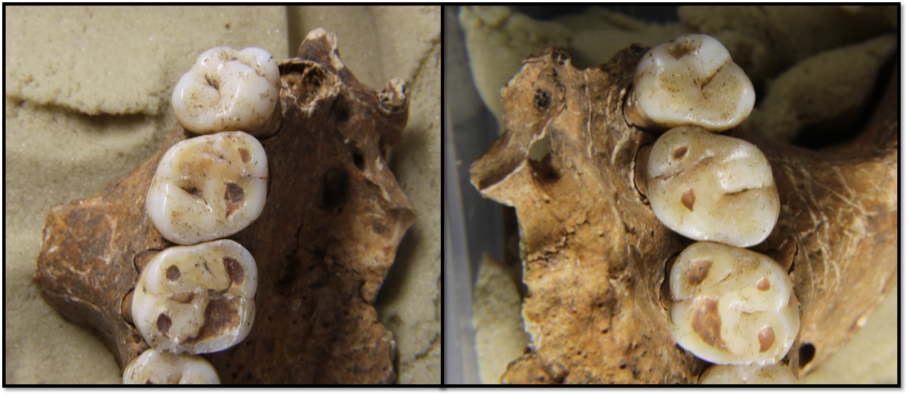Here’s a bit of a handy guide to help identify human permanent molars. At university and during my time as an undergraduate I found it quite difficult to distinguish between the different teeth – particularly the molars. As my PhD project focuses on these teeth I had to quickly gets to grips with identifying molar teeth correctly. I’ve therefore created this page to help other osteologists out there who need some extra help!
However, this is post only includes the upper and lower permanent molars as they are the teeth I am most familiar with. Also, some of the tips and features I have mentioned below are from my own observations although the majority come from Simon Hillson’s book ‘Dental Anthropology,’ (1996) which I highly recommend if you are going to spend any time looking at teeth!
Now before you start here are a couple of key words that might come in handy:
Buccal – refers to the cheek
Lingual – refers to the tongue
Mesial – directed towards the midline of the body
Distal – directed away from the midline of the body
Occlusal – a surface which comes into contact with a tooth from the opposite jaw

The Left and Right upper molars occlusal surface depicting the molar outlines.
Maxillary Vs Mandibular Molars
The first way to distinguish between the upper and lower molar is to count the number of roots. Maxillary molars have three roots whilst mandibles have two, this helps to anchor the maxillary molars into the maxilla.
General observations for the Maxillary and Mandibular Molars:
Upper
- Square-like shape when looking down at occlusal surface
- 4 cusps
- Buccal cusps tips rise higher than lingual
- Mesiobuccal most prominent
- Distolingual less prominent than the other three cusps
- Buccal side is relatively flat, whilst the lingual bulges
Lower
- Rectangular in shape
- Buccal side bugles more than the lingual
- 4 cusps arranged in the corners of the rectangle, all of which are of similar height
- Can have 3, 4 or 5 cusps. If there are only 3 cusps the distolingual cusp is absent. If there are 5 cusps an additional distobuccal cusp is added that is smaller than the others.

The Left and Right lower molars occlusal surface depicting the molar outlines.
Left Vs Right
Some tips for distinguishing between the left and right molars
Upper
- Rotate so that the roots are roots pointing up. When you look down on to the roots they form a triangle. Two points are on the buccal side and one of the lingual. Placing the single root nearest you puts the molar in anatomical position.
- Identify the most pronounced cusp of the tooth. This is the mesio-buccal cusp and as the name suggests this cusp sits on the cheek side of the molar and towards the midline of the mouth. This means that when the tooth is in anatomical position the most prominent tooth cusp is on the opposite side to the side which the molar comes from. I.e. when the prominent cusp is on the right side of the tooth, when the roots are pointing up with the single root closest to you, then the molar is from the left side of the mouth.
- Dental wear is more pronounced on the lingual (closest to the tongue) side.
Lower
- Roots generally curve towards the posterior of the mandible
- Mesial end of the occlusal outline is flat, or concave, and the distal is bulging.
- If there is a 5th cusp present it is the smallest and located in a distobuccal position. This means that the side with 3 cusps is nearest the cheek and the additional cusp is directed towards the back of the mouth.
- Mesial root is longer
- Dental wear is pronounced on the buccal (nearest the cheek) side

- The Left and Right upper molars occlusal surface depicting the molar outlines.
First, Second and Third
For both the upper and lower molars the first molars are the largest and the decrease in size as you go along the tooth row
Upper
- It can be difficult to distinguish between these molars
- M1 outline shape is trapezoidal, roots are most divergent
- M2 outline shape is squarer
- M3 outline shape is triangular but most variable, has the least divergent roots (often fused)
Lower
- M1 usually has 5 cusps, with a long occlusal outline
- M2 usually has 4 cusps, with a regular rectangular outline
- M3 can have 4 or 5 cusps, and can be variable in their shape. If the M3 has 5 cusps they are more irregular than those in the M1
- The degree of root divergent decreases as you go along the tooth row, and is often fused in the M3.

Left and Right Mandibular molars showing the buccal side
Other Helpful Links (you may need to copy and paste into your brower):
- Dental anatomy of maxillary molars by Basim Zwain http://www.slideshare.net/basimzwain/permanent-maxillary-molars
- Dental anatomy of mandibular molars by Basim Zwain http://www.slideshare.net/basimzwain/mandibular-molars-33125659
- what-when-how in depth tutorials and information: http://what-when-how.com/dental-anatomy-physiology-and-occlusion/the-permanent-mandibular-molars-dental-anatomy-physiology-and-occlusion-part-1/
Pingback: New Page – Identifying Molars | Beauty in the Bones
Thanks. Saving. Reading soon
LikeLike
This is an awesome resource, thank you! Sent it to everyone in my osteology class.
LikeLike
Thanks Maya and huge thanks for sharing! It’s good to know that others found this useful.
LikeLike
Lovely
LikeLike